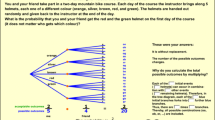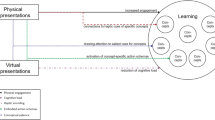Abstract
Research on the relationship between learner aptitudes and presentation modes has taken several approaches — and raised a number of questions. This study sought to clarify the relationships between modes of presentation (verbal vs. spatial), explicitness of presentation (little or much), and student aptitudes (verbal vs. spatial). Explicit guidance clearly was helpful in teaching the fourth-grade subjects, regardless of type of aptitude, how to compute surface areas of two- and three-dimensional objects. The relationship between mode of presentation and aptitude was less clear. The authors discuss their findings at length and suggest several areas for future aptitude-treatment-interaction research.
Similar content being viewed by others
References
Allen, W. H. Intellectual abilities and instructional media design.AV Communication Review, 1975,23, 139–170.
Allen, W. H., & Daehling, W. A.An exploratory study of form preception as applied to the production of educational media. Los Angeles: University of Southern California, December 1968. (ERIC Document Reproduction Service No. ED 025 943)
Bandura, A.Principles of behavior modification. New York: Holt, Reinhart and Winston, 1969.
Behr. M. J. Interactions between strucrure-of-intellect factors and two methods of presenting concepts of modular arithmetic — A summary paper.Journal of Research in Mathematics Education, 1970,1, 29–42.
Bracht, G. H. The relationship of treatment tasks, personalogical variables and dependent variables to aptitude-treatment interactions. (Doctoral dissertation, University of Colorado, 1969).Dissertation Abstracts International, 1970,30, 4268-A (University Microfilms No. 70-5820)
Cronbach, L. J., & Snow, R. E.Aptitudes and instructional methods. New York: Irvington, 1977.
French, J. W., Ekstrom, R. B., & Price, L. A.Manual for a kit of reference tests for cognitive factors. Princeton, N. J.: Educational Testing Service, 1963.
Hancock, R. R. Cognitive factors and their interaction with instructional mode.Journal for Research in Mathematics Education, 1975,6(1), 37–50.
Kirk, R. E.Experimental design: Procedures for the behavioral sciences. Belmont, Calif.: Brooks/Cole, 1968.
Markle, N. H.Increasing long term retention of knowledge: Effects on learning and retention for students of different ability levels (U.S.O.E. Final Report, Project No. 7-48-7670-204). Palo Alto, Calif.: American Institutes of Research, 1968.
Peterson, J. C., & Hancock, R. R.Developing mathematical materials for aptitude treatment interactions. Paper presented at the annual meeting of the American Educational Research Association, Chicago, April 1974.
Salomon, G. Can we affect cognitive skills through visual media?AV Communication Review, 1972,20(4), 401–422.
Salomon, G. Internalization of filmic schematic operations in interaction with learner’s aptitudes.Journal of Educational Psychology, 1974,66(4), 499–511.
Thurstone, L. L., & Thurstone, T. G.SRA Primary Mental Abilities Battery. Chicago: Science Research Associates, 1963.
Tobias, S. Achievement treatment interactions.Review of Educational Research, 1976,46(1), 61–74.
Author information
Authors and Affiliations
Rights and permissions
About this article
Cite this article
Carrier, C.A., Clark, R.E. Effects of presentation modes, explicitness, and student aptitudes on learning. ECTJ 26, 329–336 (1978). https://doi.org/10.1007/BF02766369
Issue Date:
DOI: https://doi.org/10.1007/BF02766369




